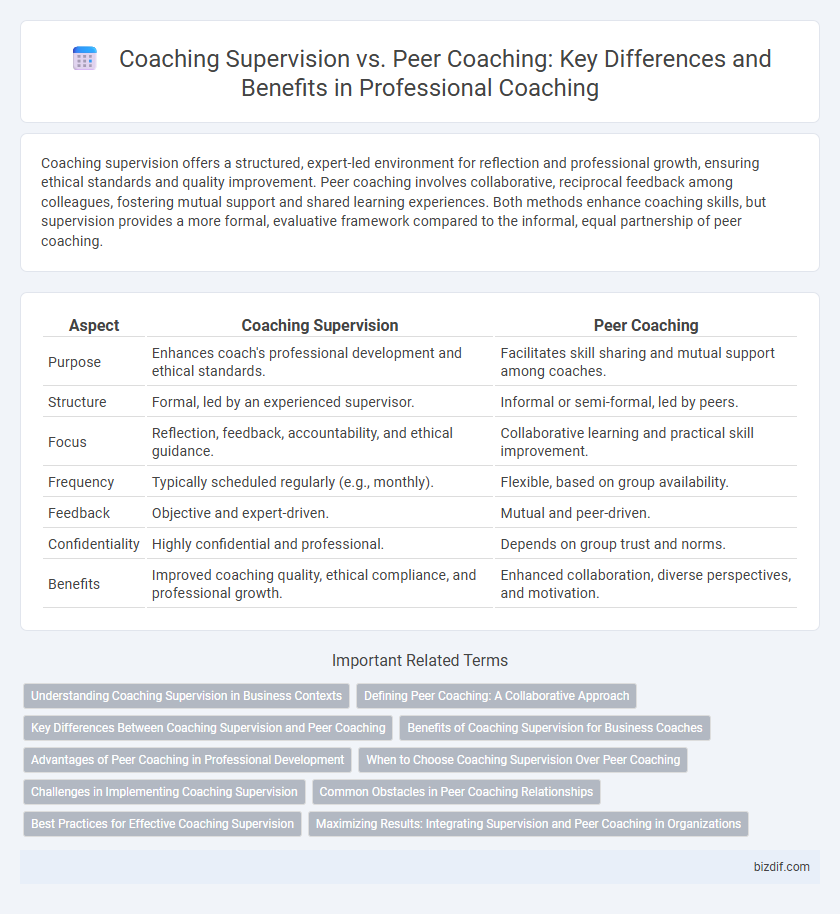Coaching supervision offers a structured, expert-led environment for reflection and professional growth, ensuring ethical standards and quality improvement. Peer coaching involves collaborative, reciprocal feedback among colleagues, fostering mutual support and shared learning experiences. Both methods enhance coaching skills, but supervision provides a more formal, evaluative framework compared to the informal, equal partnership of peer coaching.
Table of Comparison
| Aspect | Coaching Supervision | Peer Coaching |
|---|---|---|
| Purpose | Enhances coach's professional development and ethical standards. | Facilitates skill sharing and mutual support among coaches. |
| Structure | Formal, led by an experienced supervisor. | Informal or semi-formal, led by peers. |
| Focus | Reflection, feedback, accountability, and ethical guidance. | Collaborative learning and practical skill improvement. |
| Frequency | Typically scheduled regularly (e.g., monthly). | Flexible, based on group availability. |
| Feedback | Objective and expert-driven. | Mutual and peer-driven. |
| Confidentiality | Highly confidential and professional. | Depends on group trust and norms. |
| Benefits | Improved coaching quality, ethical compliance, and professional growth. | Enhanced collaboration, diverse perspectives, and motivation. |
Understanding Coaching Supervision in Business Contexts
Coaching supervision in business contexts provides structured oversight and reflective practice that enhances coaching quality and ethical standards, distinguishing it from peer coaching's reciprocal support model. Supervision involves a trained supervisor who guides the coach's professional development, ensuring alignment with organizational goals and compliance with industry regulations. This formalized process helps identify blind spots, improve coaching effectiveness, and foster continuous learning within corporate environments.
Defining Peer Coaching: A Collaborative Approach
Peer coaching is a collaborative approach where colleagues work together to reflect on their practices, share feedback, and support each other's professional growth. Unlike coaching supervision, which involves oversight by an experienced coach or supervisor, peer coaching emphasizes mutual learning through equal partnerships. This method fosters a supportive environment for skill development and problem-solving within teams.
Key Differences Between Coaching Supervision and Peer Coaching
Coaching supervision involves a structured, formal process where an experienced supervisor provides guidance, accountability, and ethical oversight to coaches, enhancing professional development and client outcomes. Peer coaching, in contrast, is a collaborative, reciprocal relationship between coaches of similar experience levels, focusing on mutual support, skill-sharing, and reflective practice without hierarchical evaluation. Key differences include the supervisory authority, goal orientation, and emphasis on ethical compliance present in coaching supervision, whereas peer coaching centers on equal partnership and shared learning.
Benefits of Coaching Supervision for Business Coaches
Coaching supervision offers business coaches a structured environment for reflective practice, enhancing self-awareness and professional growth through expert feedback. It supports ethical decision-making and accountability, ensuring higher-quality coaching outcomes for clients. This specialized guidance helps coaches navigate complex client situations, increasing effectiveness and long-term success.
Advantages of Peer Coaching in Professional Development
Peer coaching offers distinct advantages in professional development by fostering collaborative learning and mutual feedback among colleagues, which enhances skill acquisition and problem-solving. It encourages a non-hierarchical environment where professionals share real-time insights and practical experiences, promoting continuous growth. The accessibility and cost-effectiveness of peer coaching make it a sustainable option for ongoing development compared to formal supervision structures.
When to Choose Coaching Supervision Over Peer Coaching
Coaching supervision is essential when addressing complex ethical dilemmas, ensuring professional accountability, and seeking guidance from an experienced, credentialed supervisor. Peer coaching suits skill development and mutual feedback but lacks the depth of oversight and reflective practice provided by supervision. Choose coaching supervision to maintain standards, manage challenging cases, and support ongoing professional growth in a structured, confidential environment.
Challenges in Implementing Coaching Supervision
Implementing coaching supervision faces challenges such as securing trained supervisors with specialized skills and ensuring consistent, structured processes that maintain ethical standards and confidentiality. Organizations often struggle with allocating sufficient time and resources to regular supervision sessions, which can impact coaching quality and accountability. Unlike peer coaching, coaching supervision requires a hierarchical relationship that may create resistance or discomfort among coaches used to collaborative, informal interactions.
Common Obstacles in Peer Coaching Relationships
Common obstacles in peer coaching relationships include power imbalances, lack of confidentiality, and unclear boundaries, which can hinder open communication and trust. In contrast, coaching supervision offers structured support and objective feedback that helps coaches address blind spots and maintain professional standards. Peer coaching often struggles with role confusion and reluctance to provide honest critique, limiting its effectiveness compared to the formalized process of supervision.
Best Practices for Effective Coaching Supervision
Effective coaching supervision requires a structured framework that ensures regular reflective practice, feedback exchange, and ethical accountability, distinguishing it from peer coaching's collaborative learning focus. Best practices include utilizing experienced supervisors who offer objective assessments, fostering continuous professional development, and maintaining confidentiality to enhance coaching quality. Implementing standardized evaluation tools and setting clear goals further optimize coaching supervision's impact on coach performance and client outcomes.
Maximizing Results: Integrating Supervision and Peer Coaching in Organizations
Integrating coaching supervision with peer coaching maximizes organizational results by combining expert guidance with collaborative learning, fostering continuous professional development. Coaching supervision provides structured reflection and accountability, ensuring ethical practice and skill enhancement, while peer coaching encourages shared insights and mutual support. Together, they create a balanced framework that drives performance improvement and sustainable growth within teams.
Coaching supervision vs peer coaching Infographic

 bizdif.com
bizdif.com